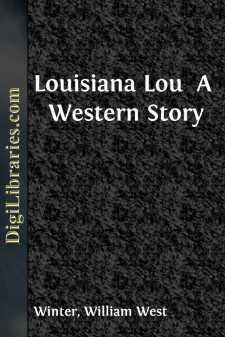Categories
- Antiques & Collectibles 13
- Architecture 36
- Art 48
- Bibles 22
- Biography & Autobiography 813
- Body, Mind & Spirit 142
- Business & Economics 28
- Children's Books 17
- Children's Fiction 14
- Computers 4
- Cooking 94
- Crafts & Hobbies 4
- Drama 346
- Education 46
- Family & Relationships 57
- Fiction 11829
- Games 19
- Gardening 17
- Health & Fitness 34
- History 1377
- House & Home 1
- Humor 147
- Juvenile Fiction 1873
- Juvenile Nonfiction 202
- Language Arts & Disciplines 88
- Law 16
- Literary Collections 686
- Literary Criticism 179
- Mathematics 13
- Medical 41
- Music 40
- Nature 179
- Non-Classifiable 1768
- Performing Arts 7
- Periodicals 1453
- Philosophy 64
- Photography 2
- Poetry 896
- Political Science 203
- Psychology 42
- Reference 154
- Religion 513
- Science 126
- Self-Help 84
- Social Science 81
- Sports & Recreation 34
- Study Aids 3
- Technology & Engineering 59
- Transportation 23
- Travel 463
- True Crime 29
Louisiana Lou A Western Story
Description:
Excerpt
PROLOGUE
The sun was westering over Ike Brandon’s ranch at Twin Forks. It was the first year of a new century when the old order was giving place to the new. Yet there was little to show the change that had already begun to take place in the old West. The desert still stretched away drearily to the south where it ended against the faint, dim line of the Esmeralda Mountains. To the north it stretched again, unpopulated and unmarked until it merged into prairie grass and again into mountains. To west and east it stretched, brown and dusty. To the south was the State of Nevada and to the north the State of Idaho. But it was all alike; bare, brown rolling plain, with naught of greenness except at the ranch where the creek watered the fields and, stretching back to the north, the thread of bushy willows and cottonwoods that lined it from its source in the mountains.
Ike Brandon was, himself, a sign of change and of new conditions, though he did not know it. A sheepman, grazing large herds of woolly pests in a country which, until recently, had been the habitat of cattlemen exclusively, he was a symbol of conquest. He remembered the petty warfare that had marked the coming of his kind, a warfare that he had survived and which had ended in a sort of sullen tolerance of his presence. A few years ago he had gone armed with rifle and pistol, and his herders had been weaponed against attack. Now he strode his acres unafraid and unthreatened, and his employees carried rifle or six-shooter only for protection against prowling coyotes or “loafer” wolves. Although the cow hands of his erstwhile enemies still belted themselves with death, they no longer made war. The sheep had come to stay.
The worst that he and his had to expect was a certain coldness toward himself on the part of the cattle aristocracy, and a measure of contempt and dislike toward his “Basco” herders on the part of the rough-riding and gentle-speaking cow hands.
These things troubled him little. He had no near neighbors. To the north, across the Idaho border, there was none nearer than Sulphur Falls, where the Serpentine, rushing tumultuously from the mountains, twisted in its cañon bed and squirmed away to westward and northward after making a gigantic loop that took it almost to the Line. To the south, a ranch at Willow Spring, where a stubborn cattleman hung on in spite of growing barrenness due to the hated sheep, was forty miles away. To east and west was no one within calling distance.
At Sulphur Falls were two or three “nesters,” irrigating land from the river, a store or two and a road house run by an unsavory holdover of the old days named “Snake” Murphy. For a hundred and twenty-five miles to southward was unbroken land. The cattle were mostly gone—though in days to come they were to return again in some measure. Even the Esmeralda Mountains were no longer roamed by populous herds. They were bare and forbidding, except where the timber was heavy, for the sheep of Brandon and others, rushing in behind the melting snow in the spring, had cropped the tender young grass before it had a chance to grow strong....


